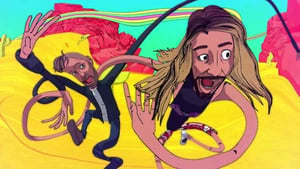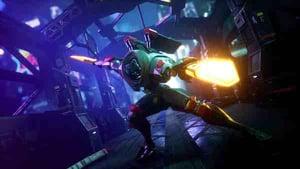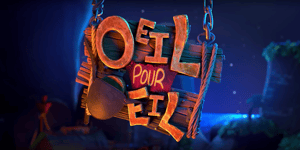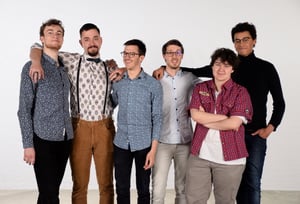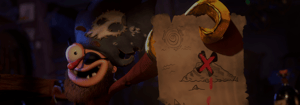
X marks the spot for ESMA and ftrack
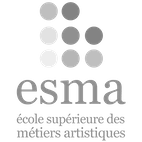
Institute: ESMA
Website: esma-artistique.com
Location: Nantes, France
The animated film Œil pour Œil is an impressive comedic, creative, and technical achievement – and all the more given that it’s the work of fourth-year students at the École Supérieure des Métiers Artistiques. We caught up with the artists and teachers at ESMA to learn more about the creation of this VES Award-nominated short.
Œil pour Œil tells the story of a hapless pirate captain on the hunt for treasure. Despite numerous attempts to locate his bounty, the corsair’s expeditions continually end in confrontation or calamity. That means replenishing his crew and heading out once again for more trial and tribulation.
Just like its animation, Œil pour Œil’s narrative is quick, punchy, and elastic, delivering knock-out laughs as quickly as the camera jumps from one scene to the next. Œil pour Œil is also an exceptionally professional endeavor in respect of its technical and artistic achievements. That makes it all the more impressive that the film is, in fact, a student project created by six artists as their fourth-year assignment at the École Supérieure des Métiers Artistiques in Nantes, France.
In Œil pour Œil, Thomas Boileau, Alan Guimont, Robin Courtoise, Mathieu Lecroq, Malcolm Hunt, and François Briantais have created a remarkable piece of work that was rightly lauded by the Spark Animation Festival’s Student Film category, and that more recently was selected as a nominee for Outstanding Visual Effects in a Student Project in the VES Awards. And this is only the start of their journey through the awards circuit.
We caught up with Œil pour Œil creator Thomas Boileau, and his instructor Christophe Moreau, to learn a little more about the project, and how ftrack helped to foster a culture of efficiency, communication, and collaboration.
|
Christophe Moreau |

Thomas Boileau |
École Supérieure des Métiers Artistiques
“ftrack was a great way to bring the team together – and to bring Œil pour Œil over the finish line.”
Why was the Œil pour Œil concept selected for this class at ESMA?
Christophe Moreau: We chose the Œil pour Œil concept as it included all the essential ingredients required for an animated short. The pitch was funny, the character design felt unique and upbeat, and it all fit perfectly with the cartoonish animation style that the students wanted to present. It was a perfect mix!
What were the core animation skills learned during the creation of this short?
Our fourth-year students created Œil pour Œil as a way to take all of the skills they had learned over previous years in class and channel them into the production of one high-quality animated short. Throughout this process, the students learned new techniques and new ways to apply their specialized technical skill sets (including animation, rigging, lighting, and compositing).
However, the essential skills that the students gained were those developed through working as a team. They learned how to discuss creative challenges, how to share different points of view (with each other and with teachers), and how to learn from one another as they progressed throughout the project.




How did you facilitate this collaborative approach throughout the production of Œil pour Œil?
We encouraged progress throughout all aspects of the short’s conception. Starting in pre-production, we helped the students to organize themselves and to plan the different tasks they would need to tackle. We helped with things that can only come from experience, like quantifying the amount of work required to carry out particular tasks. It’s important that students start thinking about these things, not solely in the context of managing their time better for this film, but also after they graduate and go on to work in real-world production environments.
With this in mind, we imparted guidance on several other topics throughout the production process, such as the optimization of tasks, the nomenclature of 3D scenes and exports of Alembic caches, the readability and uniformity of Nuke compositions, and so on. The idea is to instill the importance of consistency across all aspects of a production, so as not to waste any time.
It’s essential to train our students in this way to ensure we prepare them for what awaits. To be truly “production-ready”, students must be both artistically and technically equipped. And that’s what they learn in creating productions together like Œil pour Œil.

How does ftrack fit into a syllabus of this nature?
CM: It’s inconceivable not to use a collaborative platform like ftrack Studio to guide the production of animated shorts like Œil pour Œil. For starters, all the teachers at ESMA Nantes are professionals who have worked in production with tools like ftrack, so we know just how beneficial they can be.
Using ftrack gives oversight into the progress on a project in its entirety, by department, or by artist. Thanks to that visibility, we could track progress on Œil pour Œil and see how the students were progressing.
We also used ftrack as a communicative tool. We insisted on the students showing work updates every day, both to the creative team working on the Œil pour Œil project, but also to teachers who could provide feedback and approval on each stage of production. We used comments, review sessions, playlists, and more to facilitate that constant communication. That helped students get into the habit of presenting their work for criticism – which they will have to do a lot of in real studio environments!

What was the draw of ftrack specifically, rather than other available production platforms?
CM: The students needed something that would be easy to learn and dive into. They already have to learn a list of software as long as their arm. We didn’t want to add more complicated tools on top of that!
We tested several production platforms and ultimately chose ftrack for its simplicity, both in terms of daily use and its implementation at the school. After a successful first try on our 20-second short films at the end of the third year, we decided to adopt ftrack for the fourth-year films.
Can you tell us a little about the Œil pour Œil project and the work that you and your team performed on it?
Thomas Boileau: Œil pour Œil is the story of a pirate captain, who wants to recruit a crew to find some treasure. His journey repeatedly ends in mishaps, which means he has to keep hiring new crews for his expedition.
We wanted to create a funny and wacky universe around the story of this captain – one that would please audiences of all ages.
There were six of us on the project, working in modeling, rendering, compositing, animation, rigging, and FX. We did everything ourselves, from scriptwriting to final rendering, under the supervision of our teachers. We learned a great deal during the year and a half we worked on Œil pour Œil. Not just about art and technical requirements, but about how to work in a team and organize ourselves, as we would on a real production. Each of us improved in our unique fields, but we also developed as a team of collaborators.



How did ftrack help you to grow as collaborators on Œil pour Œil?
TB: As Christophe mentioned, we had previously used ftrack Studio on a project of smaller scale, so we were somewhat familiar with it. It significantly helped on Œil pour Œil! We used it from pre-production onwards, during this first step we would post 2D reference images, discuss important considerations, and generally make a plan of action for the project.
Using the ftrack platform, we were able to organize all of our sequences and shots and classify the work required by task categories (layout, animation, lighting, compositing, FX). We could then easily distribute the tasks to team members and check in on progress, ensuring we respected the deadlines we set for each. It helped us to grow as a tight-knit, collaborative unit.
I would say that the review tools were one of the most-used features during the production of Œil pour Œil. As soon as a member of the group updated their work, we could see it and offer precise feedback using ftrack’s review functionality, which makes things clear via its visual-led approach. Teachers could also view and make comments on any work the minute we published it, at any time of the day or night! Having all feedback centralized in this manner made us much more efficient in addressing feedback, knowing what we needed to do next, and progressing the project.
Do you think a product like ftrack is vital in the creation of projects such as Œil pour Œil?
TB: Yes! ftrack Studio had a real impact on the production of Œil pour Œil. Œil pour Œil was a complex project, but thankfully ftrack handled all of the organization for us and even automated some of the creative process. This approach allowed us to focus more on the joys of pure creation, and waste less time on needless admin and planning tasks.
There’s also a morale-boosting effect in using ftrack Studio. We can see a concrete representation of the project’s progress as we complete tasks and move items into the ‘Done’ folder. In Œil pour Œil’s more challenging moments, it was nice to see that progress and remember that things were always moving ahead.
The review sessions with the team and teachers also made a significant impact. We could easily compare versions and understand where work was needed or celebrate when something surpassed expectations. It was a great way to bring the team together – and to bring Œil pour Œil over the finish line.
More customer success stories
